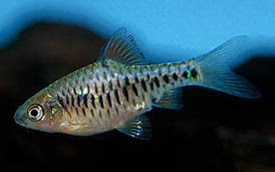Introduction
The most distinctive feature of this yellow-brown fish is the scale pattern.On prime specimens, each scale has a dark edge and front portion,which together account for the ''checkered'' effect.A dark line marks the flanks and the area below it is often less speckled on the male.Male fins are usually edge with black, while the rays of the female are generally tinted yellow.
Common Name
Checker Barb
Scientific Name
Puntius oligolepis
Species
Barbus Oligolepis
Habitat
Streams and rivers in Indonesia and Sumatra.
Maximum Size
A diminutive barb that is fully grown at around 2"/5cm.
Minimum Tank Size
A 24" x 15" x 12"/60cm x 37.5cm x 30cm/27 litre tank is ideal for a small group of these.
Diet
In nature it's mainly a benthic (bottom) feeder, consuming a variety of invertebrates and detritus. For the best condition and colours offer regular meals of small live and frozen foods such as bloodworm, Daphnia and Artemia, along with dried flakes and granules.
Water Temperature
Temperature 68 - 76°F/20 - 24°C best for this fish.
pH
6.0-7.0
Hardness
2 - 10°H
Remark
Males display to each other.
The most distinctive feature of this yellow-brown fish is the scale pattern.On prime specimens, each scale has a dark edge and front portion,which together account for the ''checkered'' effect.A dark line marks the flanks and the area below it is often less speckled on the male.Male fins are usually edge with black, while the rays of the female are generally tinted yellow.
Common Name
Checker Barb
Scientific Name
Puntius oligolepis
Species
Barbus Oligolepis
Habitat
Streams and rivers in Indonesia and Sumatra.
Maximum Size
A diminutive barb that is fully grown at around 2"/5cm.
Minimum Tank Size
A 24" x 15" x 12"/60cm x 37.5cm x 30cm/27 litre tank is ideal for a small group of these.
Diet
In nature it's mainly a benthic (bottom) feeder, consuming a variety of invertebrates and detritus. For the best condition and colours offer regular meals of small live and frozen foods such as bloodworm, Daphnia and Artemia, along with dried flakes and granules.
Water Temperature
Temperature 68 - 76°F/20 - 24°C best for this fish.
pH
6.0-7.0
Hardness
2 - 10°H
Remark
Males display to each other.















No comments:
Post a Comment